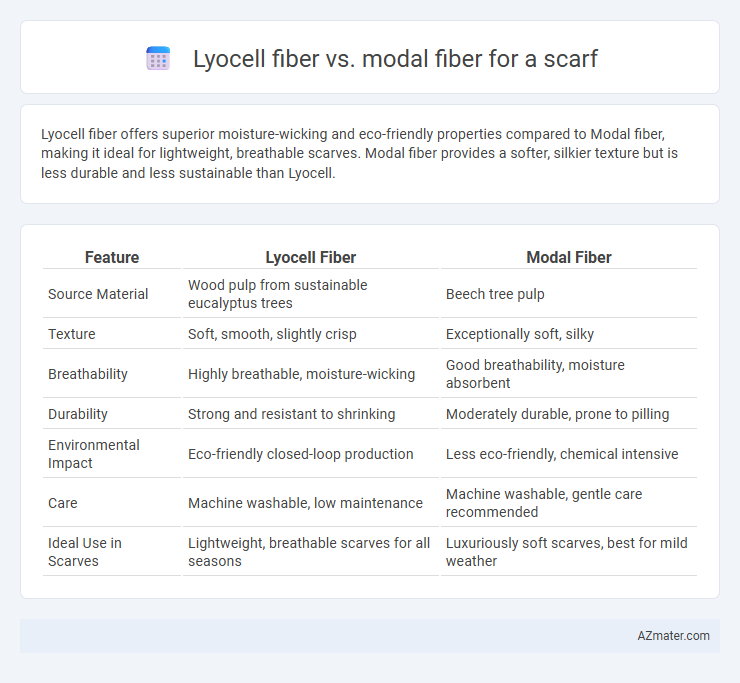Lyocell fiber offers superior moisture-wicking and eco-friendly properties compared to Modal fiber, making it ideal for lightweight, breathable scarves. Modal fiber provides a softer, silkier texture but is less durable and less sustainable than Lyocell.
Table of Comparison
| Feature | Lyocell Fiber | Modal Fiber |
|---|---|---|
| Source Material | Wood pulp from sustainable eucalyptus trees | Beech tree pulp |
| Texture | Soft, smooth, slightly crisp | Exceptionally soft, silky |
| Breathability | Highly breathable, moisture-wicking | Good breathability, moisture absorbent |
| Durability | Strong and resistant to shrinking | Moderately durable, prone to pilling |
| Environmental Impact | Eco-friendly closed-loop production | Less eco-friendly, chemical intensive |
| Care | Machine washable, low maintenance | Machine washable, gentle care recommended |
| Ideal Use in Scarves | Lightweight, breathable scarves for all seasons | Luxuriously soft scarves, best for mild weather |
Introduction to Lyocell and Modal Fibers
Lyocell fiber, made from sustainably sourced wood pulp, offers exceptional softness, breathability, and moisture-wicking properties, making it ideal for high-quality scarves. Modal fiber, derived from beech tree cellulose, is known for its smooth texture, durability, and vibrant color retention, providing a luxurious feel and longevity for scarf fabrics. Both fibers excel in eco-friendly attributes and comfort, yet Lyocell stands out for its superior environmental impact and moisture management.
Production Process: Lyocell vs Modal
Lyocell fiber is produced through a closed-loop process using non-toxic solvents to dissolve cellulose, which significantly reduces environmental impact by recycling water and chemicals. Modal fiber manufacturing involves a chemical-intensive process with alkali and carbon disulfide to treat beechwood cellulose, often resulting in higher energy consumption and emissions. The eco-friendly production of Lyocell contributes to its growing preference in sustainable scarf manufacturing over conventional Modal fibers.
Environmental Impact and Sustainability
Lyocell fiber, derived from sustainably managed eucalyptus forests and produced through a closed-loop process that recycles water and chemicals, offers a lower environmental impact compared to Modal fiber, which, although also made from beech trees, typically involves more chemical-intensive production methods. Both fibers are biodegradable and softer than traditional cotton, but Lyocell's eco-friendly manufacturing results in less water pollution and reduced carbon emissions. Choosing Lyocell scarves supports sustainable fashion by minimizing deforestation and promoting responsible resource management.
Texture and Softness Comparison
Lyocell fiber offers a smooth, silk-like texture with excellent moisture-wicking properties, making scarves breathable and comfortable for sensitive skin. Modal fiber provides an ultra-soft, supple feel with a slight stretch, enhancing drape and coziness in scarf designs. Both fibers deliver superior softness, but Lyocell's cooler touch contrasts Modal's warmer, plush sensation.
Moisture Absorption and Breathability
Lyocell fiber offers superior moisture absorption compared to Modal fiber, making it highly effective at wicking sweat away from the skin and maintaining dryness. Both fibers provide excellent breathability; however, Lyocell's more porous structure enhances airflow, contributing to a cooler and more comfortable experience when worn as a scarf. Modal fiber, while slightly less moisture-absorbent, retains softness and drapes well, but Lyocell remains the preferred choice for moisture management and breathability in scarves.
Durability and Strength of Fibers
Lyocell fiber exhibits superior durability and strength compared to Modal fiber, making it an excellent choice for scarves that require long-lasting wear and resistance to tearing. Lyocell's fiber structure provides enhanced tensile strength and resistance to abrasion, ensuring the scarf maintains its shape and softness even after multiple washes. Modal fiber, while soft and breathable, tends to be less durable under stress, with fibers more prone to pilling and weakening over time.
Dye Affinity and Color Vibrancy
Lyocell fiber exhibits excellent dye affinity, absorbing dyes deeply for rich, long-lasting color vibrancy in scarves. Modal fiber, known for its smooth surface and high moisture absorption, allows for bright and vivid hues with a soft, lustrous finish. Both fibers maintain color intensity well, but Lyocell's sustainable production often results in enhanced dye uniformity and environmental benefits.
Comfort and Skin Sensitivity
Lyocell fiber offers exceptional breathability and moisture-wicking properties, making it ideal for scarves worn against sensitive skin due to its hypoallergenic and smooth texture. Modal fiber, derived from beech trees, provides a silky softness and excellent drape, enhancing comfort while maintaining good moisture absorption to reduce irritation. Both fibers excel in softness and skin-friendliness, but Lyocell's superior moisture management often makes it the preferred choice for ultra-sensitive skin in scarf applications.
Care Instructions and Maintenance
Lyocell fiber scarves require gentle hand washing in cold water with mild detergent to maintain their natural sheen and softness, and should be air-dried flat away from direct sunlight to prevent shrinking or damage. Modal fiber scarves can be machine washed on a delicate cycle with cold water, but should avoid bleach and high heat drying to preserve their vibrant color and smooth texture. Both fibers benefit from low-temperature ironing and storing in a cool, dry place to extend scarf longevity and maintain fabric integrity.
Best Choice for Scarves: Lyocell or Modal?
Lyocell fiber offers superior moisture-wicking and breathability, making it ideal for scarves worn in various climates, while Modal fiber provides exceptional softness and a silky texture that enhances comfort and drape. Lyocell's eco-friendly production process appeals to sustainability-conscious consumers, whereas Modal excels in color retention and durability after multiple washes. For scarves prioritizing both comfort and environmental impact, Lyocell stands out as the best choice, while Modal suits those seeking luxurious softness and vibrant hues.

Infographic: Lyocell fiber vs Modal fiber for Scarf
 azmater.com
azmater.com